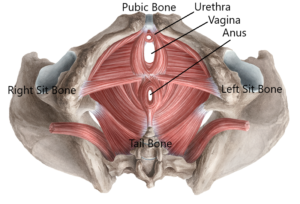Vaginismus
18 Oct 2023

Vaginismus is a diagnostic term referring to the involuntary tensing of the superficial pelvic floor muscles. But what does this mean? How does it come about? And what can be done about it?
The pelvic floor is made up of a group of small muscles, in two layers. The pelvic floor muscles attach onto and are interwoven with fascia, which is a strong, flexible connective tissue found throughout the body including the pelvis. The two layers of muscles and multiple layers of fascia form a dynamic supportive base in the pelvis, allowing the bladder, vagina, uterus, ovaries and rectum to be supported and to move, when they need to. When one area of this dynamic “team” of tissues overworks, overstretches, struggles to work, or has too much pressure over a sustained period – symptoms arise.

Vaginismus refers to the over-tensing of the pelvic floor muscles located closest to the opening of the vagina, the perineal muscles (superficial pelvic floor muscles). Typically vaginismus has been thought of as a psychological or psychiatric diagnosis. Whilst this may seem confronting, the role of the pelvic floor goes well beyond a conscious, voluntary group of muscles that can be mechanically contracted and relaxed. Pelvic floor tension is integrally connected to emotions, as well as to the function of nearby organs. In adults, fascinating research evidence shows that the pelvic floor muscles, which are involved in elimination of urine and evacuation of faeces, are the first area in the body to tense when an individual is feeling unsafe.
Vaginismus can arise from a single trigger event, such as a traumatic vaginal examination, unwanted sexual activity, a life-threatening event, including sudden-onset severe bodily pain, or another traumatic experience. This persistent pelvic floor tension can begin in early childhood, for example following an experience of being frightened whilst in a toilet. Equally, vaginismus can commence during teenage years or adulthood. As the vulva and pelvic floor is such a private, unseen part of the body, women are frequently unaware of this tension in their pelvic floor muscles, until symptoms arise. For some women, this may be during a vaginal examination by a health professional. For others, it may be on attempting to insert a tampon or menstrual cup or have penetrative intercourse.
Symptoms of vaginismus include tightening and tensing of the tissues around the vaginal opening, soreness to touch, a blocking or “brick wall” feeling on attempt to insert anything into the vagina, pulsing, throbbing, burning and aching. These symptoms at the opening of the vagina may also be associated with persistent deeper pelvic tension, jaw tension, headaches, migraines, breathing pattern changes, and widespread bodily pain.
At Consano, our specialised pelvic floor physiotherapists consider the contributing factors to the tension, as well as current symptoms. We take a sensitive approach to assessing women who present with a diagnosis or symptoms of vaginismus, including to vulval and vaginal examination. Treatment is individualized and our practitioners are experienced at retraining the pelvic floor to release tension. With our holistic approach, women can learn to feel this part of the body and be instrumental in their own healing.

